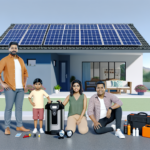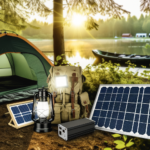Introduction to Solar-Powered Living
The Importance of Sustainable Living
In today’s world, the urgency of adopting sustainable living practices cannot be overstated. The environmental impact of our traditional energy consumption methods, primarily reliant on fossil fuels, has led to significant climate change, pollution, and resource depletion. Sustainable living aims to reduce our carbon footprint, conserve natural resources, and promote a healthier planet for future generations. By integrating renewable energy sources like solar power into our daily lives, we can make a substantial difference in mitigating these environmental issues.
Benefits of Solar Power
Solar power stands out as one of the most promising renewable energy sources. Here are some key benefits:
- Environmental Impact: Solar energy is clean and green. It produces no greenhouse gases or pollutants, significantly reducing our carbon footprint.
- Renewable and Abundant: The sun provides an inexhaustible source of energy. Unlike fossil fuels, solar energy is renewable and available almost everywhere.
- Cost Savings: While the initial investment in solar technology can be high, the long-term savings on energy bills are substantial. Solar panels can last for decades, providing free energy after the initial payback period.
- Energy Independence: Solar power allows individuals and communities to become less dependent on centralized power grids, which are often powered by non-renewable sources.
- Low Maintenance: Solar power systems require minimal maintenance. Once installed, they can operate efficiently with little intervention.
Overview of a Solar-Powered Toolkit
A solar-powered toolkit is an essential collection of components and devices designed to harness solar energy for various applications. This toolkit can be tailored to meet different energy needs, from small-scale personal use to larger, off-grid living solutions. Here’s a brief overview of what a typical solar-powered toolkit includes:
- Solar Panels: These are the primary components that capture sunlight and convert it into electrical energy. They come in various sizes and efficiencies, suitable for different applications.
- Charge Controllers: These devices regulate the voltage and current coming from the solar panels to the batteries, preventing overcharging and ensuring optimal battery life.
- Batteries: Energy storage solutions that store the electricity generated by the solar panels for use when sunlight is not available, such as during the night or cloudy days.
- Inverters: These convert the direct current (DC) produced by solar panels and stored in batteries into alternating current (AC), which is used by most household appliances.
- Cables and Connectors: Essential for connecting all the components of the solar power system, ensuring efficient and safe energy transfer.
By assembling a solar-powered toolkit, individuals can take a significant step towards sustainable living. Whether for reducing energy bills, living off-grid, or preparing for emergencies, a well-designed solar power system offers a reliable and eco-friendly energy solution.
Essential Components of a Solar-Powered Toolkit
Solar Panels
Solar panels are the heart of any solar-powered toolkit. These devices convert sunlight into electricity through photovoltaic cells. When choosing solar panels, consider factors such as efficiency, size, and type. Monocrystalline panels are known for their high efficiency and compact size, making them ideal for limited spaces. Polycrystalline panels are less efficient but more cost-effective. Thin-film panels are flexible and lightweight, suitable for portable applications. The number of panels you need depends on your energy requirements and the amount of sunlight your location receives.
Charge Controllers
A charge controller is essential for regulating the voltage and current coming from the solar panels to the batteries. It prevents overcharging and deep discharging, which can damage the batteries. There are two main types of charge controllers: Pulse Width Modulation (PWM) and Maximum Power Point Tracking (MPPT). MPPT controllers are more efficient as they adjust the input voltage to harvest the maximum power from the solar panels. When selecting a charge controller, ensure it matches the voltage of your solar panels and batteries.
Batteries
Batteries store the electricity generated by the solar panels for use when sunlight is not available. The most common types of batteries used in solar setups are lead-acid and lithium-ion. Lead-acid batteries are cheaper but have a shorter lifespan and lower efficiency. Lithium-ion batteries are more expensive but offer longer life, higher efficiency, and lighter weight. When choosing batteries, consider their capacity (measured in ampere-hours, Ah) and depth of discharge (DoD). A higher DoD means you can use more of the battery’s capacity without damaging it.
Inverters
Inverters convert the direct current (DC) produced by solar panels and stored in batteries into alternating current (AC), which is used by most household appliances. There are three main types of inverters: pure sine wave, modified sine wave, and grid-tie inverters. Pure sine wave inverters provide clean power similar to the grid, making them suitable for sensitive electronics. Modified sine wave inverters are cheaper but may not be compatible with all devices. Grid-tie inverters are used in systems connected to the utility grid, allowing excess power to be fed back into the grid.
Cables and Connectors
Cables and connectors are the unsung heroes of a solar-powered toolkit, ensuring that all components are properly connected and functioning. Use high-quality, weather-resistant cables to handle the current from your solar panels to the charge controller, batteries, and inverter. The gauge of the cable should be appropriate for the current it will carry to minimize energy loss. Connectors, such as MC4 connectors, are commonly used for their reliability and ease of installation. Properly sized fuses and circuit breakers are also crucial for protecting your system from electrical faults.
By understanding and selecting the right components, you can assemble a solar-powered toolkit that meets your energy needs and supports sustainable living.
Choosing the Right Solar Equipment
Assessing Your Energy Needs
Before diving into the specifics of solar equipment, it’s crucial to assess your energy needs. Start by listing all the devices and appliances you plan to power with your solar toolkit. Calculate their total energy consumption in watt-hours (Wh) per day. This will help you determine the size and number of solar panels, batteries, and other components you’ll need. For instance, if you plan to power a laptop, lights, and a small refrigerator, you’ll need to know their individual energy requirements to size your system appropriately.
Types of Solar Panels
Solar panels are the heart of any solar-powered toolkit. There are three main types to consider:
- Monocrystalline Panels: These are the most efficient and durable, but also the most expensive. They are ideal for small spaces where maximum efficiency is needed.
- Polycrystalline Panels: Slightly less efficient than monocrystalline panels, but more affordable. They are a good middle-ground option.
- Thin-Film Panels: These are the least efficient but are lightweight and flexible, making them suitable for portable applications.
When choosing solar panels, consider factors like efficiency, cost, and the available space for installation. For example, if you have limited space, monocrystalline panels might be the best choice despite their higher cost.
Battery Options and Storage Solutions
Batteries are essential for storing the energy generated by your solar panels. The two most common types are:
- Lead-Acid Batteries: These are the most affordable but have a shorter lifespan and lower energy density. They are suitable for small-scale, budget-conscious setups.
- Lithium-Ion Batteries: These are more expensive but offer a longer lifespan, higher energy density, and better efficiency. They are ideal for more demanding applications and long-term use.
When selecting a battery, consider its capacity (measured in amp-hours or Ah), lifespan, and cost. For instance, a 100 Ah lead-acid battery might be sufficient for a small setup, but if you need more storage and longer life, a lithium-ion battery would be a better investment.
Selecting the Right Inverter
Inverters convert the direct current (DC) produced by solar panels and stored in batteries into alternating current (AC) used by most household appliances. There are two main types:
- Pure Sine Wave Inverters: These provide clean, stable power suitable for sensitive electronics like laptops and medical equipment. They are more expensive but offer better performance.
- Modified Sine Wave Inverters: These are cheaper but produce a less stable power output, which can be problematic for some devices. They are suitable for less sensitive equipment like lights and simple tools.
When choosing an inverter, consider the total wattage of the devices you plan to power and ensure the inverter can handle that load. For example, if your total load is 500 watts, choose an inverter with a capacity of at least 600 watts to provide a safety margin.
By carefully assessing your energy needs and selecting the appropriate solar panels, batteries, and inverters, you can assemble a solar-powered toolkit that meets your requirements and supports sustainable living.
Assembling Your Solar-Powered Toolkit
Step-by-Step Assembly Guide
Assembling a solar-powered toolkit can seem daunting, but with a clear step-by-step guide, it becomes a manageable and rewarding project. Here’s how to get started:
1. **Gather Your Components**: Ensure you have all the essential components: solar panels, charge controllers, batteries, inverters, and the necessary cables and connectors.
2. **Mount the Solar Panels**: Position your solar panels in a location that receives maximum sunlight, typically on a rooftop or an open area. Secure them using appropriate mounts and brackets.
3. **Connect the Charge Controller**: The charge controller regulates the voltage and current coming from the solar panels to the batteries. Connect the solar panels to the charge controller using the appropriate cables.
4. **Install the Batteries**: Place your batteries in a well-ventilated area. Connect the batteries to the charge controller, ensuring the polarity is correct to avoid damage.
5. **Set Up the Inverter**: The inverter converts the DC power stored in the batteries to AC power, which is used by most household appliances. Connect the inverter to the batteries.
6. **Wiring and Connections**: Use the appropriate cables and connectors to link all components. Ensure all connections are secure and insulated to prevent short circuits.
7. **Test the System**: Before finalizing the setup, test the system to ensure everything is working correctly. Check the voltage and current at various points to confirm proper operation.
Safety Precautions
Safety is paramount when working with electrical components. Here are some key precautions to follow:
– **Wear Protective Gear**: Always wear gloves and safety glasses to protect yourself from electrical shocks and injuries.
– **Avoid Wet Conditions**: Never work on your solar setup in wet conditions to prevent electrical hazards.
– **Proper Insulation**: Ensure all cables and connectors are properly insulated to avoid short circuits and electrical fires.
– **Follow Manufacturer Instructions**: Adhere to the instructions provided by the manufacturers of the solar panels, charge controllers, batteries, and inverters.
– **Disconnect Power**: Before making any adjustments or repairs, disconnect the power supply to avoid accidental shocks.
– **Regular Inspections**: Periodically inspect your setup for any signs of wear and tear, loose connections, or corrosion.
Testing Your Setup
Once your solar-powered toolkit is assembled, it’s crucial to test the system to ensure it operates efficiently and safely.
1. **Initial Power-Up**: Turn on the system and check if the solar panels are generating power. The charge controller should indicate the charging status.
2. **Battery Check**: Verify that the batteries are charging correctly. Use a multimeter to measure the voltage and ensure it matches the specifications.
3. **Inverter Functionality**: Test the inverter by connecting a small appliance. Ensure the appliance operates smoothly without any interruptions.
4. **Load Testing**: Gradually increase the load on the system by connecting more appliances. Monitor the system’s performance and ensure it handles the load without issues.
5. **Monitor Performance**: Use the monitoring features of your charge controller and inverter to keep track of the system’s performance over time. Look for any irregularities or drops in efficiency.
By following these steps and precautions, you can successfully assemble and test your solar-powered toolkit, paving the way for a more sustainable and energy-efficient lifestyle.
Maintaining and Troubleshooting Your Solar Toolkit
Routine Maintenance Tips
Maintaining your solar-powered toolkit is essential to ensure its longevity and efficiency. Here are some routine maintenance tips to keep your system running smoothly:
- Regular Cleaning: Dust, dirt, and debris can accumulate on solar panels, reducing their efficiency. Clean the panels with a soft cloth and mild detergent every few months or after a significant weather event.
- Inspect Connections: Periodically check all cables and connectors for signs of wear, corrosion, or loose connections. Tighten any loose connections and replace damaged components as needed.
- Monitor Battery Health: Batteries are a critical component of your solar toolkit. Regularly check the battery voltage and electrolyte levels (for lead-acid batteries). Ensure that the batteries are not overcharged or deeply discharged, as this can shorten their lifespan.
- Check Charge Controllers: Ensure that the charge controllers are functioning correctly by monitoring the input and output voltages. Look for any error messages or warning lights that may indicate a problem.
- Inspect Inverters: Inverters convert DC power from the batteries to AC power for household use. Regularly check the inverter for any signs of overheating, unusual noises, or error codes.
Common Issues and Solutions
Even with regular maintenance, you may encounter some common issues with your solar-powered toolkit. Here are a few problems and their solutions:
- Reduced Power Output: If your solar panels are not generating as much power as expected, check for shading, dirt, or damage to the panels. Clean the panels and remove any obstructions. If the problem persists, test the panels individually to identify any faulty units.
- Battery Not Charging: If the batteries are not charging, check the connections between the solar panels, charge controller, and batteries. Ensure that the charge controller settings are correct and that the panels are receiving adequate sunlight. If the batteries are old, they may need to be replaced.
- Inverter Issues: If the inverter is not working correctly, check the input voltage from the batteries and the output voltage to your appliances. Ensure that the inverter is not overloaded and that it is properly ventilated to prevent overheating. Reset the inverter if necessary.
- System Overheating: Overheating can occur if components are not adequately ventilated. Ensure that all parts, especially the inverter and batteries, have sufficient airflow. Install cooling fans if necessary.
Upgrading Your System
As your energy needs grow or as new technology becomes available, you may want to upgrade your solar-powered toolkit. Here are some tips for upgrading your system:
- Increase Solar Panel Capacity: Adding more solar panels can increase your system’s power generation capacity. Ensure that your charge controller can handle the additional input and that you have enough space for the new panels.
- Upgrade Batteries: Consider upgrading to higher-capacity or more efficient batteries, such as lithium-ion batteries, which offer longer lifespans and better performance than traditional lead-acid batteries.
- Install a More Efficient Inverter: Upgrading to a more efficient inverter can reduce energy losses and improve the overall performance of your system. Look for inverters with higher efficiency ratings and advanced features like remote monitoring.
- Integrate Smart Technology: Incorporate smart technology to monitor and control your solar system remotely. Smart charge controllers, inverters, and battery management systems can provide real-time data and alerts, helping you optimize your system’s performance.
By following these maintenance tips, addressing common issues promptly, and considering upgrades, you can ensure that your solar-powered toolkit remains efficient and reliable for years to come.
Practical Applications of a Solar-Powered Toolkit
Camping and Outdoor Adventures
Solar-powered toolkits are a game-changer for camping and outdoor adventures. Imagine being able to charge your devices, power lights, and even run small appliances without relying on traditional batteries or generators. **Solar panels** can be easily mounted on your tent or RV, capturing sunlight throughout the day. **Portable solar chargers** are also available, which can be used to charge phones, GPS devices, and cameras. This not only reduces the need to carry extra batteries but also ensures that you have a reliable power source in remote locations.
For those who enjoy extended stays in nature, a **solar-powered water purifier** can be a lifesaver. These devices use solar energy to filter and purify water, making it safe to drink. This is particularly useful in areas where clean water is not readily available. Additionally, **solar cookers** can be used to prepare meals without the need for firewood or gas, making your camping experience more sustainable and eco-friendly.
Living Off-Grid
Living off-grid is becoming increasingly popular as people seek to reduce their carbon footprint and live more sustainably. A solar-powered toolkit is essential for anyone looking to make this transition. **Solar panels** can be installed on rooftops or in open spaces to capture sunlight and convert it into electricity. This energy can then be stored in **batteries** for use during the night or on cloudy days.
**Inverters** are crucial for converting the DC power generated by solar panels into AC power, which is used by most household appliances. With a well-assembled solar-powered toolkit, you can power everything from lights and refrigerators to washing machines and computers. This not only reduces your reliance on the grid but also lowers your energy bills.
For those living in remote areas, a **solar-powered water pump** can be used to draw water from wells or rivers, providing a reliable water supply without the need for electricity. **Solar heaters** can also be used to provide hot water for bathing and cooking, further enhancing your off-grid living experience.
Emergency Preparedness
In times of natural disasters or power outages, a solar-powered toolkit can be invaluable. **Portable solar generators** can provide emergency power for essential devices such as medical equipment, communication devices, and lights. This ensures that you remain connected and safe even when the grid is down.
**Solar-powered radios** and **flashlights** are also essential components of an emergency kit. These devices can be charged during the day and used at night, providing reliable light and communication without the need for batteries. **Solar chargers** can keep your phones and other devices powered, allowing you to stay in touch with loved ones and emergency services.
For those living in areas prone to hurricanes or earthquakes, a **solar-powered water desalination** device can provide clean drinking water when traditional sources are compromised. This not only ensures your survival but also reduces the need for bottled water, which can be scarce during emergencies.
In summary, a solar-powered toolkit offers numerous practical applications, from enhancing your camping experience to enabling off-grid living and ensuring emergency preparedness. By harnessing the power of the sun, you can create a more sustainable and resilient lifestyle.
Future Trends in Solar Technology
Innovations in Solar Panels
The solar panel industry is continuously evolving, with new technologies emerging to enhance efficiency and reduce costs. One of the most promising advancements is the development of *perovskite solar cells*. These cells offer high efficiency and can be manufactured at a lower cost compared to traditional silicon-based cells. Researchers are also exploring *tandem solar cells*, which layer different materials to capture a broader spectrum of sunlight, thereby increasing overall efficiency.
Another exciting innovation is the integration of *bifacial solar panels*. Unlike traditional panels that only capture sunlight on one side, bifacial panels can absorb light from both sides, increasing energy yield. Additionally, *transparent solar panels* are being developed for use in windows and other surfaces, allowing buildings to generate their own electricity without compromising aesthetics.
Advancements in Battery Technology
As solar power generation increases, the need for efficient energy storage solutions becomes more critical. Recent advancements in battery technology are addressing this need. *Lithium-ion batteries* remain the most popular choice due to their high energy density and long cycle life. However, new materials and designs are pushing the boundaries of what these batteries can achieve.
*Solid-state batteries* are one such innovation, offering higher energy densities and improved safety over traditional lithium-ion batteries. These batteries replace the liquid electrolyte with a solid one, reducing the risk of leaks and fires. Another promising development is the *flow battery*, which uses liquid electrolytes stored in external tanks. Flow batteries are scalable and can store large amounts of energy, making them ideal for grid storage applications.
Smart Solar Solutions
The integration of smart technology with solar power systems is revolutionizing how we generate and use energy. *Smart inverters* are a key component of this transformation. These devices convert the direct current (DC) produced by solar panels into alternating current (AC) used by most household appliances. Smart inverters can also communicate with the grid, optimizing energy flow and improving system reliability.
*Energy management systems (EMS)* are another critical innovation. These systems use advanced algorithms and real-time data to manage energy production, storage, and consumption. By integrating with smart home devices, EMS can optimize energy use based on factors like weather forecasts, electricity prices, and household energy needs.
Finally, the rise of the *Internet of Things (IoT)* is enabling more sophisticated solar solutions. IoT devices can monitor and control various aspects of a solar power system, from panel performance to battery health. This connectivity allows for predictive maintenance, reducing downtime and extending the lifespan of solar installations.
In conclusion, the future of solar technology is bright, with continuous innovations in solar panels, battery technology, and smart solutions driving the industry forward. These advancements not only make solar power more efficient and cost-effective but also pave the way for a more sustainable and resilient energy future.






